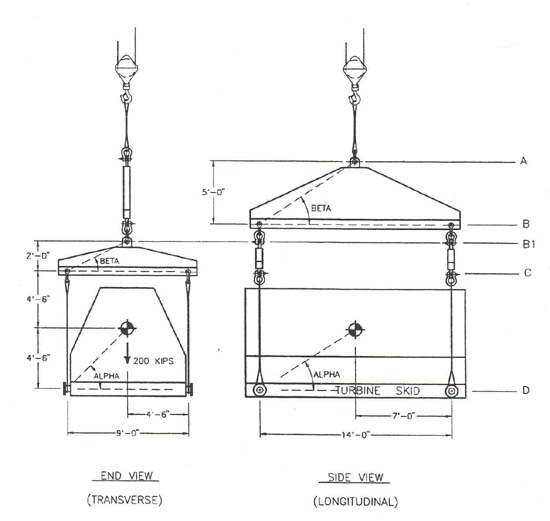
-
The answer is no, this is not a safe lift. It is unstable against tipping in the transverse direction and borderline stable against tipping in the longitudinal direction.
This is because the angle Alpha below the center of gravity (CG) in the transverse direction is 45 degrees, and the angle Beta at the spreader bar is approximately 24 degrees. In order to be stable, Beta must be greater than Alpha.
For the longitudinal direction, angle Alpha is 32.75 degrees and angle Beta at the spreader bar is approximately 35 degrees. As Beta is greater than Alpha, theoretically, it is stable.
To better understand why the angle Beta at the spreader bar (or slings if they are being used above the spreader bar) must be larger than the corresponding angle Alpha at the CG in both the transverse and longitudinal direction, consider the following. Assume that the pick point "B1" in the transverse direction is actually located at "C" and centered between the shackle points. If the CG was located directly under the hook and could be kept there, then the load would be stable. But the location of the CG for a load is hard to calculate and is usually off by at least several inches to a foot. During lifting, dynamics of the lift, wind, different lengths of rigging, etc., tend to also shift the location of the CG. Therefore, if the CG is not under the hook as the load is lifted, the offset CG will cause the load to rotate away from the hook, and in so doing, the spreader bar and the skid platform will form a parallelogram as they rotate from the horizontal. As there is no resisting force against overturning or tipping, the spreader bar and skid platform will continue rotating into a more acute parallelogram until the slings bear up against the sides of the turbine. If the trunnions were located outside of the turbine frame, then the skid would turn up side down.
Consider one more situation where the skid is being lifted in the transverse direction without spreader bars, but with slings attached at the trunnions on the "D" line and connected to the pick points or hooks at a point below the CG. Also assume that there is no interference between the inclined slings and the turbine housing. As in the example above, there is no resisting force against overturning as the CG is located above the pick points or hooks & the skid is therefore unstable. Now, if the slings are lengthened until the pick points are above the CG, they provide a resisting force against overturning and the load will be stable.
So whether the slings are connected to the tunnnions and run directly to the hook, or they start at the spreader bar and go to the pick points or hooks, they must form an angle Beta that is greater than the angle Alpha at the CG. If the CG is not centered between the skid pick points, then both Alpha angles in the transverse and both Alpha angles in the longitudinal must be computed and compared with the corresponding Beta angles.
Now the most often asked question is how much greater must angle Beta be than angle Alpha. Theoretically and on paper, if Beta is as great as say one degree larger than Alpha, the lift should be stable. But due to the dynamics of lifting, the CG location not always being know accurately, the slings not always matched for length, etc, it is recommended that Beta be at least 20 degrees larger than Alpha. In most cases this will be conservative but safe.
Maximum Reach Enterprises